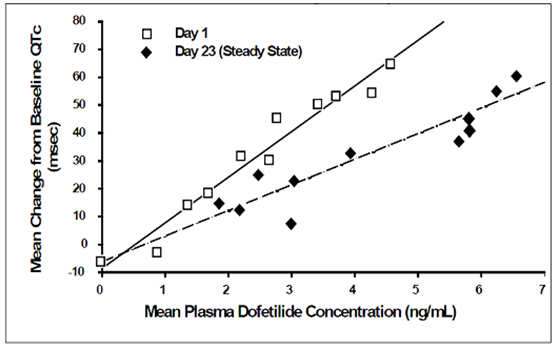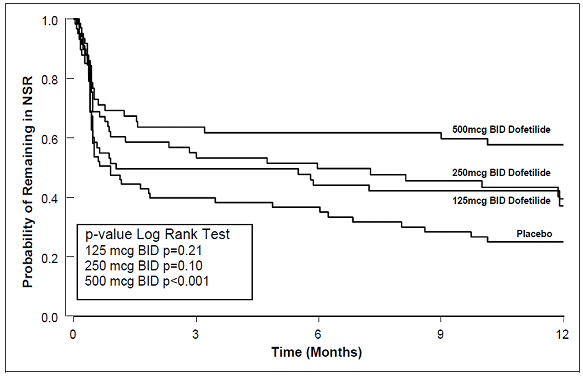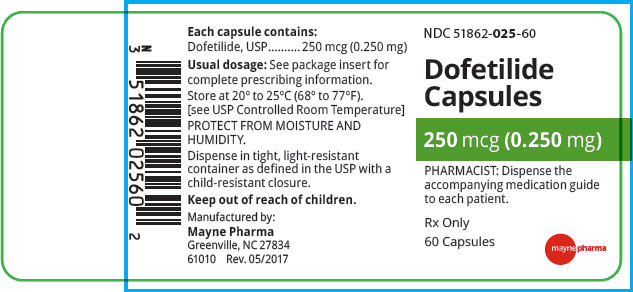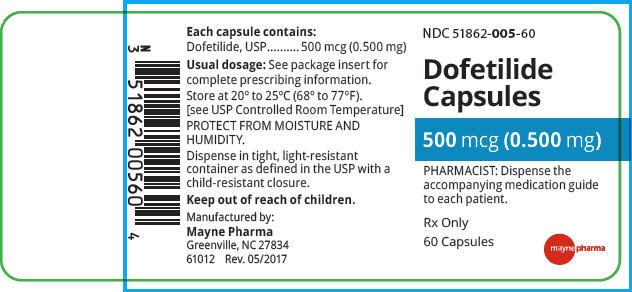Drug Catalog - Product Detail
DOFETILIDE CP 125MCG 60
| NDC | Mfr | Size | Str | Form |
|---|---|---|---|---|
| 51862-0125-60 | MAYNE PHARMA | 60 | 125MCG | CAPSULE |
PACKAGE FILES









Generic Name
DOFETILIDE
Substance Name
DOFETILIDE
Product Type
HUMAN PRESCRIPTION DRUG
Route
ORAL
Application Number
ANDA207058
Description
DESCRIPTION Dofetilide capsules are an antiarrhythmic drug with Class III (cardiac action potential duration prolonging) properties. Its empirical formula is C 19 H 27 N 3 O 5 S 2 and it has a molecular weight of 441.6. The structural formula is The chemical name for dofetilide is: N -[4-[2-[methyl[2-[4-[(methylsulfonyl)amino]phenoxy]ethyl]amino]ethyl]phenyl]methanesulfonamide. Dofetilide is a white to off-white powder. It is very slightly soluble in water and propan-2-ol and is soluble in 0.1M aqueous sodium hydroxide, acetone, and aqueous 0.1M hydrochloric acid. Dofetilide capsules contain the following inactive ingredients: microcrystalline cellulose, corn starch, colloidal silicon dioxide and magnesium stearate. The capsule shells contain gelatin, titanium dioxide, red iron oxide, yellow iron oxide, and black ink. The imprint ink contains iron oxide black, shellac, ethanol, n-butyl alcohol, isopropyl alcohol, propylene glycol, and ammonium hydroxide. Dofetilide capsules are supplied for oral administration in three dosage strengths: 125 mcg (0.125 mg) dark caramel and white capsules, 250 mcg (0.25 mg) light orange capsules, and 500 mcg (0.5 mg) light orange and white capsules. Chemical Structure
How Supplied
HOW SUPPLIED Dofetilide capsules, 125 mcg (0.125 mg) are supplied as No. 4 capsules with a dark caramel cap and white body, imprinted with ML 125 in black ink, and are available in: Dofetilide capsules, 250 mcg (0.25 mg) are supplied as No. 4 capsules with a light orange cap and light orange body, imprinted with ML 250 in black ink, and are available in: Dofetilide capsules, 500 mcg (0.5 mg) are supplied as No. 2 capsules with a light orange cap and white body, imprinted with ML 500 in black ink, and are available in: 125 mcg (0.125 mg) 250 mcg (0.25 mg) 500 mcg (0.5 mg) Body 125 250 500 Cap ML ML ML Bottle of 60 51862-125-60 51862-025-60 51862-005-60 Storage Store at 20° to 25°C (68° to 77°F). [See USP Controlled Room Temperature.] PROTECT FROM MOISTURE AND HUMIDITY. Dispense in a tight, light-resistant container as defined in the USP using a child-resistant closure.
Indications & Usage
INDICATIONS AND USAGE Maintenance of Normal Sinus Rhythm (Delay in AF/AFl Recurrence) Dofetilide capsules are indicated for the maintenance of normal sinus rhythm (delay in time to recurrence of atrial fibrillation/atrial flutter [AF/AFl]) in patients with atrial fibrillation/atrial flutter of greater than one week duration who have been converted to normal sinus rhythm. Because dofetilide capsules can cause life threatening ventricular arrhythmias, it should be reserved for patients in whom atrial fibrillation/atrial flutter is highly symptomatic. In general, antiarrhythmic therapy for atrial fibrillation/atrial flutter aims to prolong the time in normal sinus rhythm. Recurrence is expected in some patients (see CLINICAL STUDIES ). Conversion of Atrial Fibrillation/Flutter Dofetilide capsules are indicated for the conversion of atrial fibrillation and atrial flutter to normal sinus rhythm. Dofetilide capsules have not been shown to be effective in patients with paroxysmal atrial fibrillation.
Dosage and Administration
DOSAGE AND ADMINISTRATION Therapy with dofetilide capsules must be initiated (and, if necessary, re-initiated) in a setting that provides continuous electrocardiographic (ECG) monitoring and in the presence of personnel trained in the management of serious ventricular arrhythmias. Patients should continue to be monitored in this way for a minimum of three days. Additionally, patients should not be discharged within 12 hours of electrical or pharmacological conversion to normal sinus rhythm. The dose of dofetilide capsules must be individualized according to calculated creatinine clearance and QTc. (QT interval should be used if the heart rate is <60 beats per minute. There are no data on use of dofetilide capsules when the heart rate is <50 beats per minute.) The usual recommended dose of dofetilide capsules is 500 mcg BID, as modified by the dosing algorithm described below. For consideration of a lower dose, see Special Considerations below. Serum potassium should be maintained within the normal range before dofetilide capsules treatment is initiated and should be maintained within the normal range while the patient remains on dofetilide capsules therapy. (See WARNINGS, Hypokalemia and Potassium-Depleting Diuretics ). In clinical trials, potassium levels were generally maintained above 3.6-4.0 mEq/L. Patients with atrial fibrillation should be anticoagulated according to usual medical practice prior to electrical or pharmacological cardioversion. Anticoagulant therapy may be continued after cardioversion according to usual medical practice for the treatment of people with AF. Hypokalemia should be corrected before initiation of dofetilide capsules therapy (see WARNINGS, Ventricular Arrhythmia ). Patients to be discharged on dofetilide capsules therapy from an inpatient setting as described above must have an adequate supply of dofetilide capsules, at the patient's individualized dose, to allow uninterrupted dosing until the patient can fill a dofetilide capsules prescription. Instructions for Individualized Dose Initiation Initiation of Dofetilide Capsules Therapy Step 1. Electrocardiographic assessment: Prior to administration of the first dose, the QTc or QT must be checked using an average of 5-10 beats. If the QTc or QT is greater than 440 msec (500 msec in patients with ventricular conduction abnormalities), dofetilide capsules are contraindicated. If heart rate is less than 60 beats per minute, QT interval should be used. Proceed to Step 2 if the QTc or QT is 440 msec. Patients with heart rates <50 beats per minute have not been studied. Step 2. Calculation of creatinine clearance: Prior to the administration of the first dose, the patient's creatinine clearance must be calculated using the following formula: creatinine clearance (male) = (140-age) × actual body weight in kg 72 × serum creatinine (mg/dL) creatinine clearance (female) = (140-age) × actual body weight in kg × 0.85 72 × serum creatinine (mg/dL) When serum creatinine is given in µmol/L, divide the value by 88.4 (1 mg/dL = 88.4 µmol/L). Step 3. Starting Dose: The starting dose of dofetilide capsules is determined as follows: Calculated Creatinine Clearance Dofetilide Capsules Dose >60 mL/min 500 mcg twice daily 40 to 60 mL/min 250 mcg twice daily 20 to <40 mL/min 125 mcg twice daily <20 mL/min Dofetilide capsules are contraindicated in these patients Step 4. Administer the adjusted dofetilide capsules dose and begin continuous ECG monitoring. Step 5. At 2-3 hours after administering the first dose of dofetilide capsules, determine the QTc or QT (if heart rate is less than 60 beats per minute). If the QTc or QT has increased by greater than 15% compared to the baseline established in Step 1 OR if the QTc or QT is greater than 500 msec (550 msec in patients with ventricular conduction abnormalities), subsequent dosing should be adjusted as follows: If the Starting Dose Based on Creatinine Clearance is: Then the Adjusted Dose (for QTc or QT Prolongation) is: 500 mcg twice daily 250 mcg twice daily 250 mcg twice daily 125 mcg twice daily 125 mcg twice daily 125 mcg once a day Step 6. At 2-3 hours after each subsequent dose of dofetilide capsules, determine the QTc or QT (if heart rate is less than 60 beats per minute) (for in-hospital doses 2-5). No further down titration of dofetilide capsules based on QTc or QT is recommended. NOTE: If at any time after the second dose of dofetilide capsules is given the QTc or QT is greater than 500 msec (550 msec in patients with ventricular conduction abnormalities), dofetilide capsules should be discontinued. Step 7. Patients are to be continuously monitored by ECG for a minimum of three days, or for a minimum of 12 hours after electrical or pharmacological conversion to normal sinus rhythm, whichever is greater. The steps described above are summarized in the following diagram: Figure Maintenance of Dofetilide Capsules Therapy Renal function and QTc or QT (if heart rate is less than 60 beats per minute) should be re-evaluated every three months or as medically warranted. If QTc or QT exceeds 500 milliseconds (550 msec in patients with ventricular conduction abnormalities), dofetilide capsules therapy should be discontinued and patients should be carefully monitored until QTc or QT returns to baseline levels. If renal function deteriorates, adjust dose as described in Initiation of Dofetilide Capsules Therapy, Step 3. Special Considerations Consideration of a Dose Lower than that Determined by the Algorithm The dosing algorithm shown above should be used to determine the individualized dose of dofetilide capsules. In clinical trials (see CLINICAL STUDIES ), the highest dose of 500 mcg BID of dofetilide capsules as modified by the dosing algorithm led to greater effectiveness than lower doses of 125 or 250 mcg BID as modified by the dosing algorithm. The risk of Torsade de Pointes, however, is related to dose as well as to patient characteristics (see WARNINGS ). Physicians, in consultation with their patients, may therefore in some cases choose doses lower than determined by the algorithm. It is critically important that if at any time this lower dose is increased, the patient needs to be rehospitalized for three days. Previous toleration of higher doses does not eliminate the need for rehospitalization. The maximum recommended dose in patients with a calculated creatinine clearance greater than 60 mL/min is 500 mcg BID; doses greater than 500 mcg BID have been associated with an increased incidence of Torsade de Pointes. A patient who misses a dose should NOT double the next dose. The next dose should be taken at the usual time. Cardioversion If patients do not convert to normal sinus rhythm within 24 hours of initiation of dofetilide capsules therapy, electrical conversion should be considered. Patients continuing on dofetilide capsules after successful electrical cardioversion should continue to be monitored by electrocardiography for 12 hours post cardioversion, or a minimum of 3 days after initiation of dofetilide capsules therapy, whichever is greater. Switch to Dofetilide Capsules from Class I or other Class III Antiarrhythmic Therapy Before initiating dofetilide capsules therapy, previous antiarrhythmic therapy should be withdrawn under careful monitoring for a minimum of three (3) plasma half-lives. Because of the unpredictable pharmacokinetics of amiodarone, dofetilide capsules should not be initiated following amiodarone therapy until amiodarone plasma levels are below 0.3 mcg/mL or until amiodarone has been withdrawn for at least three months. Stopping Dofetilide Capsules Prior to Administration of Potentially Interacting Drugs If dofetilide capsules need to be discontinued to allow dosing of other potentially interacting drug(s), a washout period of at least two days should be followed before starting the other drug(s).
